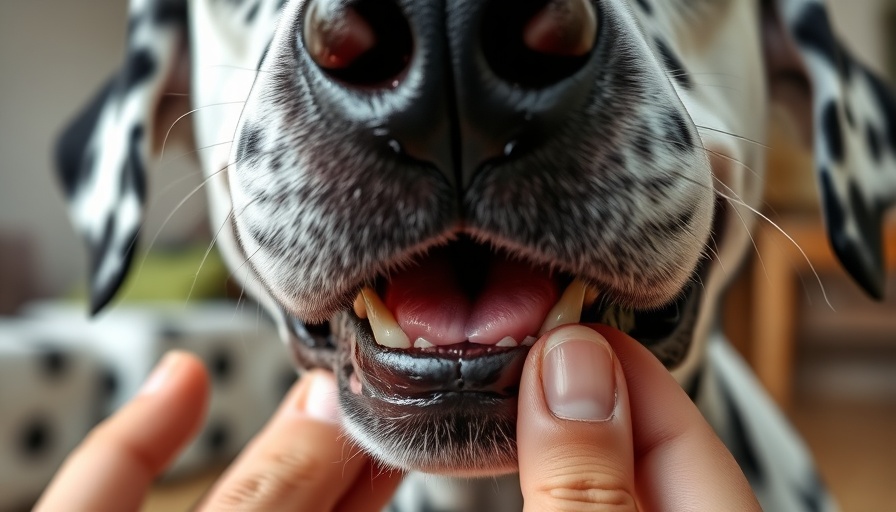
Understanding Your Dog's Gum Color: A Simple Check
Pale gums in dogs are more than just a minor health indicator; they can be a crucial sign that something more serious is occurring within your pet's body. Healthy gums should be a vibrant bubble-gum pink, moist, and should respond quickly to pressure. However, when the color shifts to pale pink, white, or even grey, it raises immediate concerns about poor circulation or serious medical conditions.
Checking your dog's gums is a simple yet vital check you can perform regularly at home. Just lift their lip and observe. The capillary refill time—a measure of how quickly the gum returns to pink after being pressed—should take no more than two seconds. If it takes longer and the gums feel sticky or dry, it could be a signal of hydration or more serious issues. Remember to regularly inspect your dog’s gums, as early intervention can lead to better health outcomes.
Why Pale Gums Matter: Recognizing the Signs
One of the most alarming signs for dog owners is a shift in gum color. Pale gums often suggest that there isn’t enough oxygen-rich blood circulating through the body. This can arise from a variety of serious health conditions, including anemia, shock, or internal bleeding.
Discussing three potential causes of pale gums helps illustrate the importance of recognizing this warning sign:
- Anemia: Anemia can arise from several sources, including blood loss, destruction of red blood cells, or decreased production due to health issues like organ failure. Without adequate red blood cells, your dog may suffer from a lack of energy and pale gums.
- Dehydration: On occasion, dehydration can cause slightly pale gums, so ensure your furry friend has constant access to fresh water and monitor their hydration levels.
- Internal Bleeding: More severe and critical issues include tumors or injuries causing internal bleeding, which rapidly depletes blood volume and brings on extreme pale gums.
The Lifesaving Value of Regular Checks
Do you routinely check your dog's gum color? This simple action can be instrumental in safeguarding their health. Performing this check once or twice a month, and more frequently if you notice health changes, can assist in catching underlying issues early.
Key indicators to look for include:
- Gum color changes, ranging from pink to yellow (indicating liver issues) or even bluish (suggesting oxygen deprivation).
- Capillary refill time exceeding three seconds.
- A texture that is dry or sticky when it should feel moist and slick.
Act Fast: Emergency Signs You Shouldn't Ignore
If you notice your dog’s gums are pale, especially if they accompany other symptoms like weakness, difficulty breathing, or unusual lethargy, it’s time to seek immediate veterinary help.
Common emergency signs include:
- Sudden weakness or collapse.
- Fast or labored breathing.
- Change in appetite or drinking habits.
When it comes to your dog's health, acting swiftly can be the difference between a full recovery and a dire outcome.
The Essential Role of Veterinary Visits
Regular veterinary check-ups are fundamental in monitoring your dog's overall health. During routine evaluations, vets perform thorough assessments including blood tests that can provide insight into your dog's red blood cell levels and overall circulatory health.
Imagine if a simple check-up could catch a potential heart issue before it turns critical! This is why routine vet visits, along with maintaining a healthy diet and a clean living environment, are critical:
- Prevention of health risks through early detection and comprehensive care.
- Guidance on nutrition and lifestyle choices that can boost your pet's health.
- Access to parasite control to reduce risks associated with blood-sucking pests.
Conclusion: Empower Yourself with Knowledge
As a dog owner, being knowledgeable about your dog's health can empower you to act quickly when needed. Recognizing the signs of pale gums and understanding their significance will allow you to ensure your beloved pet receives timely care. Remember, those bubble-gum pink gums are not just about aesthetics—they're a reflection of your dog's internal health, and every slight change deserves your attention.
Don't wait until your pet shows significant signs of distress. Make gum checking a routine part of your care regimen. Your dog's health is invaluable—taking this simple step could save their life!
 Add Row
Add Row  Add
Add 




Write A Comment